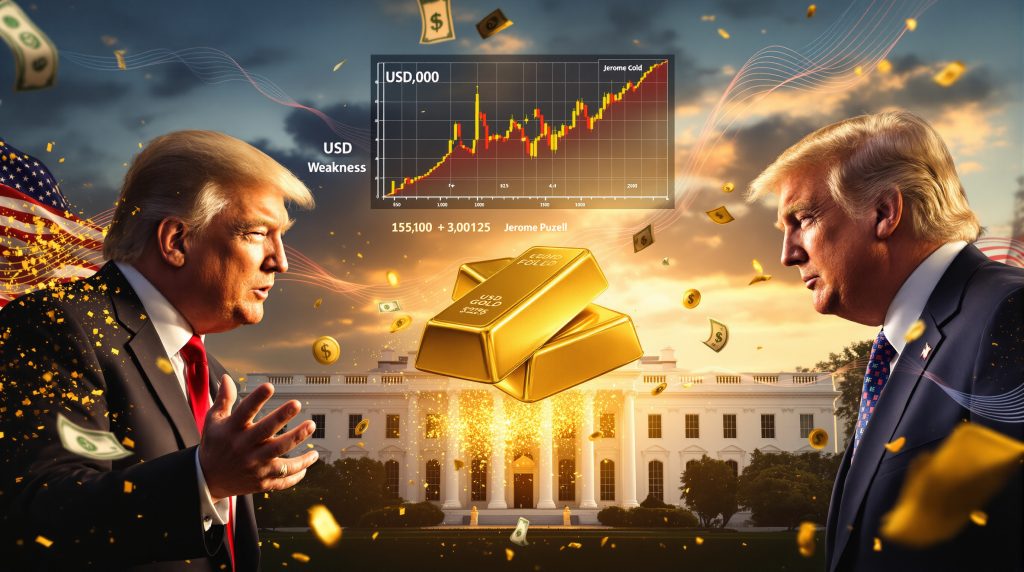Political Tensions Drive Currency Weakness and Gold Strength
The deteriorating relationship between executive leadership and Federal Reserve policy continues reshaping precious metals markets in 2025. Recent developments show the US dollar index declining 0.5% over five trading sessions, whilst gold surged past $3,400 per ounce to reach month-long highs. This pattern reflects broader concerns about monetary policy independence and institutional credibility affecting global financial stability. Furthermore, analysis of gold price highs analysis reveals how Trump-Powell feud and US dollar impact on gold prices creates fundamental shifts in investment strategies.
Currency debasement creates fundamental shifts in investment allocation strategies. Professional portfolio managers increasingly view precious metals as essential hedges against political interference in central banking operations. The mechanics become clear when examining how gold gained 2% weekly whilst maintaining strength across multiple currency pairs, including £2,533 per ounce in British pounds and €2,900 per ounce in euros.
Federal Reserve Independence Under Pressure
Market participants demonstrate heightened sensitivity to political pressure on monetary policy frameworks. Recent episodes involving potential leadership changes at the Federal Reserve created immediate volatility across asset classes. Bond yields spiked before recovering when speculation about chair replacement subsided, illustrating how quickly institutional confidence concerns translate into market movements. Moreover, the historic gold surge explained demonstrates these broader implications.
The transmission mechanism operates through multiple channels:
• Policy uncertainty: Markets struggle to price future rate decisions when political influence increases
• Currency volatility: Dollar weakness accelerates during periods of institutional doubt
• Flight-to-quality flows: International capital seeks alternatives to traditional reserve assets
• Central bank diversification: Sovereign reserves shift toward precious metals during uncertainty
Professional investors recognise these patterns from historical precedents. The 1970s demonstrated how political pressure on monetary policy creates sustained precious metals bull markets. Current dynamics suggest similar structural forces may drive long-term price appreciation beyond immediate political tensions. In addition, understanding the Trump tariff economic impact provides essential context for current market conditions.
How Do Silver Markets Respond to Dollar Weakness?
Silver performance reveals additional complexity in precious metals markets during political-monetary conflicts. The metal reached near 14-year highs at $39.27 per ounce, with €33.61 representing all-time highs in euro terms. This outperformance reflects silver's dual role as both monetary alternative and industrial commodity. Consequently, experts highlight silver market squeeze dynamics as critical factors.
Supply-demand fundamentals support silver's exceptional gains:
• Industrial demand growth: Technology sector expansion requires increasing silver consumption
• Monetary demand surge: Investors seek alternatives during currency instability
• Supply constraints: Mining production fails to meet accelerating consumption
• Investment flows: Exchange-traded products experience sustained inflows
Technical analysis confirms fundamental strength, with silver approaching the UK record of £29.26 whilst establishing new resistance levels across multiple currency pairs. These developments suggest structural changes in precious metals markets extend beyond temporary political tensions.
Interest Rate Policy Disputes Create Market Volatility
Disagreements over appropriate monetary policy create cascading effects throughout financial markets. When political figures advocate aggressive rate cutting whilst central bankers maintain cautious approaches, precious metals benefit from multiple dynamics simultaneously. Real yield compression reduces opportunity costs of holding non-yielding assets, whilst currency weakness enhances international buying power. However, concerns about US inflation and debt complicate these dynamics further.
The August 1st tariff deadline and July 30th Federal Reserve decision create concentrated risk events for precious metals pricing. Historical analysis suggests such convergence points often produce significant price movements as markets resolve uncertainty through rapid repricing mechanisms.
Professional traders position for volatility through specific allocation strategies:
• Core physical holdings: 20-30% portfolio weights in precious metals
• Tactical mining equity exposure: Leveraged plays during momentum phases
• Currency hedging strategies: Multi-national exposure reducing dollar concentration
• Options strategies: Volatility-based approaches capturing price swings
Bond Market Vigilantes and Fiscal Policy
Rising national deficits across developed economies create additional pressure points for precious metals markets. Bond vigilantes increasingly target countries where fiscal policy appears unsustainable or political interference threatens monetary policy independence. This dynamic creates feedback loops supporting precious metals demand as traditional fixed-income alternatives lose credibility.
International yield movements demonstrate these concerns:
| Country | 10-Year Yield Change | Fiscal Deficit (% GDP) | Gold Holdings (Tonnes) |
|---|---|---|---|
| United States | +0.15% | -6.8% | 8,133 |
| Germany | +0.08% | -2.1% | 3,355 |
| Japan | +0.03% | -4.2% | 845 |
| United Kingdom | +0.12% | -5.4% | 310 |
These patterns suggest systematic shifts in how markets evaluate sovereign creditworthiness when political pressures affect monetary policy independence. Central banks respond by increasing precious metals reserves as insurance against currency instability and fiscal credibility challenges.
Global Market Transmission Mechanisms
International financial markets amplify American political-monetary tensions due to the dollar's reserve currency status. Emerging market capital outflows accelerate when US institutional stability faces challenges, creating secondary effects in commodity markets and regional currencies. These dynamics support precious metals pricing through multiple transmission channels.
Foreign exchange markets demonstrate particular sensitivity to Fed independence concerns. Currency volatility spikes during political tensions create hedging demand for monetary alternatives. Professional currency managers increasingly allocate portions of reserves toward precious metals during periods of elevated institutional risk. Furthermore, according to Reuters analysis, tariff negotiations add additional complexity to these market dynamics.
"Historical precedents suggest political pressure on central banks creates sustained rather than temporary precious metals strength, as institutional credibility takes time to rebuild once damaged."
What Are the Technical Price Dynamics During Political Events?
Chart analysis reveals how political catalysts interact with established technical levels in gold markets. The recent breakthrough above $3,400 coincided with political announcements about Federal Reserve policy, demonstrating convergence between fundamental and technical factors. These interactions help professional traders identify optimal positioning during volatility periods.
Key technical observations include:
• Momentum acceleration: Political events often trigger breakouts through resistance levels
• Support validation: Uncertainty resolution typically confirms established price floors
• Volume characteristics: Political volatility creates higher than normal trading activity
• Cross-currency strength: Broad-based gains across currency pairs indicate fundamental drivers
Professional technical analysts emphasise that political events rarely create lasting price moves without underlying fundamental support. Current precious metals strength reflects both immediate political tensions and longer-term structural concerns about monetary system stability. In fact, Fortune reports indicate these tensions continue affecting market sentiment.
Long-Term Monetary System Evolution
Recurring political challenges to central bank independence raise fundamental questions about future monetary architecture. These structural concerns drive precious metals demand beyond immediate political cycles. Alternative monetary systems development accelerates when traditional frameworks face credibility challenges, creating sustained support for monetary alternatives.
Regional currency initiatives gain momentum during periods of reserve currency instability:
• Central bank digital currencies: National alternatives to dollar-based systems
• Bilateral trade agreements: Non-dollar settlement mechanisms
• Commodity-backed currencies: Resource-based monetary alternatives
• Precious metals reserves: Increased sovereign holdings for monetary insurance
These developments suggest structural rather than cyclical changes in global monetary systems. Professional investors position for potential paradigm shifts by maintaining diversified precious metals exposure across multiple storage jurisdictions and currency denominations.
Investment Strategy Implementation
Strategic positioning for ongoing political-monetary volatility requires balancing immediate opportunities with longer-term structural trends. Successful navigation demands understanding both technical market dynamics and fundamental institutional changes affecting precious metals demand. Consequently, Trump-Powell feud and US dollar impact on gold prices remains a critical consideration for portfolio allocation.
Risk management approaches emphasise position sizing appropriate for heightened volatility environments. Professional managers typically increase precious metals allocations during periods of institutional uncertainty whilst maintaining geographic diversification across storage locations.
Implementation frameworks focus on:
• Phased accumulation: Dollar-cost averaging during volatile periods
• Storage diversification: Geographic distribution reducing political risk
• Currency diversification: Multi-national exposure limiting single-country risk
• Liquidity maintenance: Preserving ability to capitalise on opportunity creation
Disclaimer: Precious metal investments carry inherent risks including price volatility and potential capital loss. Political and monetary policy developments create additional uncertainty that may affect investment performance. This analysis represents educational content rather than specific investment advice, and readers should conduct independent research before making investment decisions.
Market participants continue monitoring the Trump-Powell feud and US dollar impact on gold prices as these political dynamics evolve through upcoming Federal Reserve meetings and policy announcements. The convergence of technical price levels with fundamental political tensions suggests continued volatility and potential for significant precious metals price movements in coming months.
Want to Stay Ahead of Mining Discovery Opportunities?
While political tensions drive gold to new heights, Discovery Alert's proprietary Discovery IQ model identifies emerging ASX mineral discoveries that could benefit from precious metals strength and currency instability. Begin your 30-day free trial today to receive real-time alerts on significant discoveries and position yourself ahead of the market during these volatile times.




